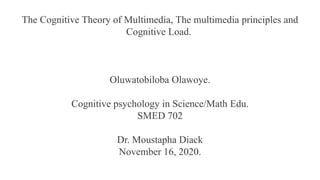
Module 6 702
- 1. The Cognitive Theory of Multimedia, The multimedia principles and Cognitive Load. Oluwatobiloba Olawoye. Cognitive psychology in Science/Math Edu. SMED 702 Dr. Moustapha Diack November 16, 2020.
- 2. The Cognitive Theory of Multimedia Learning (CTML) 2 MULTIMEDIA LEARNING IS A COGNITIVE THEORY OF LEARNING WHICH HAS BEEN POPULARIZED BY THE WORK OF RICHARD E. MAYER AND OTHERS. MULTIMEDIA LEARNING HAPPENS WHEN WE BUILD MENTAL REPRESENTATIONS FROM WORDS AND PICTURES. GENERALLY, THESE THEORY TRIES TO ADDRESS THE ISSUE OF HOW TO STRUCTURE MULTIMEDIA INSTRUCTIONAL PRACTICES AND EMPLOY MORE EFFECTIVE COGNITIVE STRATEGIES TO HELP PEOPLE LEARN EFFICIENTLY.
- 3. The Cognitive Theory of Multimedia Learning 3 THE ARGUMENT IS THAT MULTIMEDIA SUPPORTS THE WAY THAT THE HUMAN BRAIN LEARNS. PEOPLE LEARN MORE DEEPLY FROM WORDS AND PICTURES THAN FROM WORDS ALONE. THIS IS REFERRED TO AS THE MULTIMEDIA PRINCIPLE (MAYER 2005A).
- 4. The Cognitive Theory of Multimedia Learning is based on 3 assumptions 4 The dual-channel assumption is that working memory has auditory and visual channels (Pavio, 1971) The limited capacity assumption is based on cognitive load theory and states that each subsystem of working memory has a limited capacity. The active processing assumption suggests that people construct knowledge in meaningful ways when they (a) pay attention to the relevant material, (b) organize it into a coherent mental structure, and (c) integrate it with their prior knowledge
- 6. Learning Graphics Words The Multimedia Principle • Use words and graphics rather than words alone • Text means either spoken or written form • Graphics must be explanative, not decorative • Why? • Relevant graphics promote active learning • i.e. Learners make connections between the text and the graphics Attempt to use cognitive research to combine words and pictures in ways that maximize learning effectiveness. Source- https://www.slideshare.net/ebloomsie/cognitive-theory-of-multimedia-learning
- 7. • Coherence Principle • Signaling Principle • Redundancy Principle • Spatial Contiguity Principle • Temporal Contiguity Principle • Segmenting Principle 12 practical principles • Pre‐training Principle • Modality Principle • Multimedia Principle • Personalization Principle • Voice Principle • Image Principle
- 8. • Coherence Principle- States that all unnecessary information in multimedia messages should be eliminated, such as sound, images and words as they may. decrease the learning. • Signaling Principle- Explains that people learn better when cues that highlight the organization of the material are added. • Redundancy principle- States that learners can learn better just with animation and narration. • Spatial Contiguity Principle- Students learn better when corresponding words and pictures are presented near rather than far from each other on the page or screen.
- 9. • Temporal contiguity- This occurs when two stimuli are experienced close together in time and, as a result an association may be formed. • Segmenting principle- It states that “people learn better when a multimedia message is presented in user-paced segments rather than as a continuous unit. • Pre-Training Principle- This principle encourages instructors to introduce key terms and concepts before asking learners to engage with the actual lesson material to reduce cognitive load. • Modality principle- states that low‐experience learners more successfully understand information that uses narration rather than on‐screen text.
- 10. • Multimedia principle- It states that people tend learn better from words and pictures than from words alone. • Personalization principle- This is based on engaging the learner by the way of delivering content in a conversational tone to bring increase to learning experience. • Voice principle- This explains that people learn more deeply when the words in a multimedia message are spoken in a human voice rather than in a machine voice. • Image Principle- It explains that humans do not really learn better from a talking head video.
- 11. Cognitive Load 11 Cognitive Load Theory was developed by John Sweller. He published a paper on the subject in the journal Cognitive Science in 1988. While in the past the theory has been applied primarily to technical areas, it is now being applied to more language-based discursive areas. This relates to the amount of information that working memory can hold at one time.
- 12. The Triarchic model of Cognitive Load framework based on the three types of cognitive load (Mayer 2009). 12 Essential processing (intrinsic load) it relates to the essential material or information to be learned. Extraneous processing (extrinsic load) does not serve the instructional goal or purpose and reduces the chances that transfer of learning will occur. Generative processing (germane cognitive load) is aimed at making sense of the presented material. It is the activity of organizing and integrating information in working memory
- 13. This is explaining is that we should stop spending time and attention on unimportant tasks and activities and do the things that are of importance first. Information and cognitive overload lead to a loss of control over much of our professional and personal lives.
- 14. References • Richard Mayer (2001). Multi-Media Learning. Cambridge University Press • Clark, Ruth and Richard Mayer (2002). E-Learning and the Science of Instruction: Proven Guidelines for Consumers and Designers of Multimedia Learning. Jossey-Bass Pfeiffer • Clark, Ruth and Chopeta Lyons (2004). Graphics for Learning: Proven Guidelines for Planning, Designing and Evaluating Visuals in Training Materials. Jossey-Bass Pfeiffer • Clark, R. C., & Mayer, R. E. (2016). E-learning and the science of instruction : Proven guidelines for consumers and designers of multimedia learning. Retrieved from http://ebookcentral.proquest.com • Mayer, R. (2014). The Cambridge Handbook of Multimedia Learning, Second Edition. New York City: Cambridge University Press.
- 15. THANK YOU.